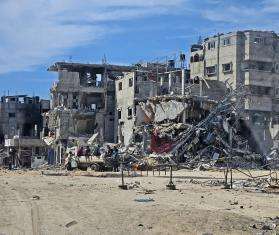Françoise Bouchet-Saulnier, author of The Practical Guide to Humanitarian Law, considers the notion of the “responsibility to protect,” which has been raised, incorrectly, given the obstacles to international assistance in Myanmar following Cyclone Nargis. She is the legal director of Doctors Without Borders/Médecins Sans Frontières (MSF) in France.
Is there a legal framework for international humanitarian assistance in the case of natural disasters?
As established by resolutions of the UN General Assembly, the rules applicable during natural disasters are based on two key notions: the responsibility of the affected State to coordinate and provide aid to the populations on its territory and to facilitate the operations of aid organizations; and, international solidarity to support affected countries and strengthen their ability to act when it is inadequate.
However, neither a right nor obligation of international control exists for distributing aid. Thus, there is no provision for a case in which a State refuses this cooperation and no authorization to override such a refusal. NGOs and States may not ignore the government in question, even when it is an authoritarian regime, and must negotiate with it regarding the possibility and forms of intervention.
The only entity that may legally impose a decision on a State is the Security Council of the United Nations, which may decide to use force under Chapter VII of the U.N. Charter; that is, under its powers in the case of threats to peace.
Thus, there is no legal rule that would make it possible to force the Myanmar government to allow international aid workers into the country to set up aid operations following Cylcone Nargis.
What is the “responsibility to protect”?
Political leaders have referred publicly to this idea in the Myanmar context. However, the “responsibility to protect” does not address obstacles to humanitarian aid in the case of natural disasters. It involves a process that expands the UN Security Council’s opportunity to use force in the case of genocide, war crimes, ethnic cleansing, and crimes against humanity.
The “responsibility to protect” clearly involves a development in the law. The Security Council is no longer required to prove that a threat to peace exists in order to take coercive measures against a State, but even in situations of genocide or crimes against humanity this right remains “virtual” because it has been deferred to a case-by-case consensus vote within the Security Council.
In Myanmar, the populations are currently in an extremely precarious situation and the obstacles to humanitarian aid are real, but that does not reach a qualification of genocide or mass crime and the Security Council has failed to reach a consensus on this issue.
Are existing regulatory provisions adequate?
The pressing need today is not to change the law, but to clarify the alternatives to the use of force. In the case of Myanmar, the urgent need is to bring together the general outrage and the diplomatic synergies in the face of obstacles and a level of suffering that are unanimously considered to be unacceptable.
The notion of the “right to intervene” has also been raised. What does this cover?
It is important to remember that the “right to intervene” does not exist in international humanitarian law. “Intervention” is not a defined legal concept.
“Intervention” has been used to refer to some NGOs that enter a country without the government’s agreement. First of all, “intervention” in the literal sense has never occurred, because NGOs have always worked in an area of a country with the agreement of those who controlled it. For example, in the 1980s, MSF worked in Afghanistan with the agreement of the mujahadeen in the areas it controlled, but without the agreement of the central government in Kabul.
Political leaders seized on this notion of “intervention,” suggesting that States could require or force a government to accept a foreign presence. As a result “humanitarian intervention” entered the vocabulary. But we shouldn’t be mistaken about what it means, because “humanitarian intervention” clearly involves military force. Chapter VII of the UN Charter provides the legal framework here, too, as in the case of the 1990-91 Persian Gulf War and the 1992 war in Somalia.
We must also point out that delivering aid by force does not guarantee its distribution. Furthermore, we must question the usefulness of this concept of militarized deployment of humanitarian aid because the use of force involves long lead times and does not necessarily mean improved aid to populations.
On the contrary there is a real risk of militarizing and politicizing aid and, thus, of extending the violence. Convoys cannot be protected without entering into conflict at some point with those who are controlling the territory, as was the case in Somalia in 1992. Humanitarian intervention is a soft word whose efficiency is more to cover for military activities than humanitarian relief.



